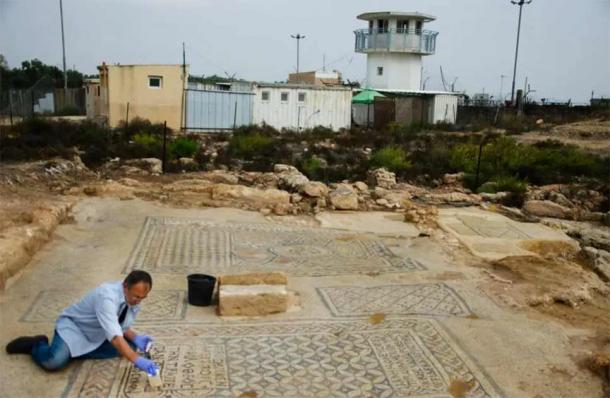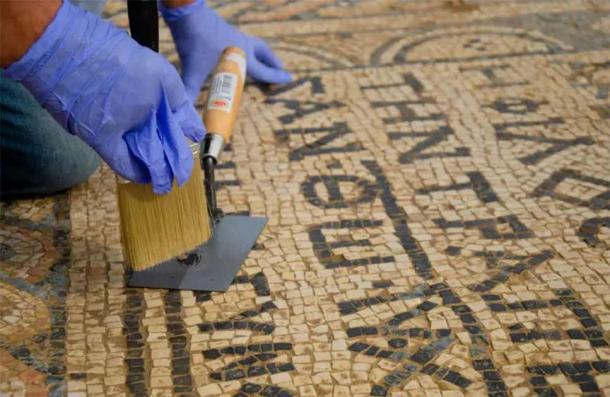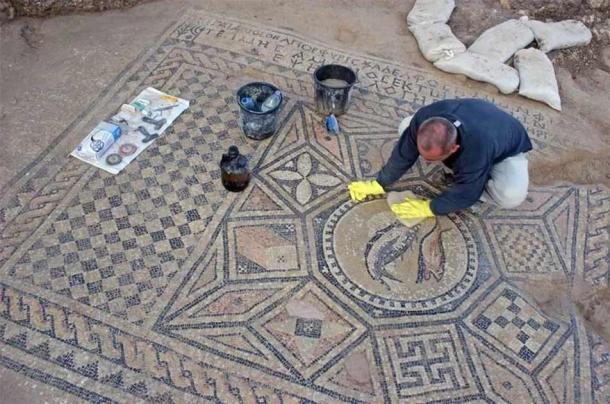An ancient mosaic found among historic ruins in Megiddo in northern Israel has been deemed so historically significant that extraordinary efforts will be undertaken to make sure it is protected and available to be studied. This remarkable mosaic floor was originally installed inside an early Christian prayer house in the third century AD, and it is the earliest known mosaic to be dedicated to Jesus. The truth about its origin and meaning was revealed by a Greek inscription on the prison mosaic, which reads “to God Jesus Christ.”
Unfortunately, this valuable and rare historical artifact is located within the walls of Megiddo Prison, which was built before the prison mosaic was uncovered by archaeologists during excavations that took place between 2004 and 2008. This has limited the ability of academics to visit the site of the mosaic, but a radical solution has been approved that will solve this problem once and for all. Rather than attempting to dig up and move the mosaic, which could damage or even destroy it, plans have been made to close the current prison and move it to an entirely different location.
The astonishing decision was announced by the Israel Antiquities Authority on March 28. Officials from the Megiddo Regional Council and the Israel Prison Service hope the relocation of the prison can be completed over the summer, after which archaeologists and tourists will both be free to visit and investigate the site.

The Early Christian prison mosaic during excavations at Megiddo Prison in Israel. ( Israel Antiquities Authority )
Magnificent Prison Mosaic Revealed Behind the Walls of Megiddo Prison
In 2004, archaeologists affiliated with the Israel Antiquities Authority arrived at the site of Megiddo Prison in northern Israel, to begin an exploratory dig on prison grounds. The excavations were ordered by the Israel Prisons Service, in anticipation of an upcoming construction project that might endanger hidden archaeological treasures.
The name Megiddo is well-known in Christian tradition. In the New Testament Book of Revelations, the foreboding hill known as Mount Megiddo was identified as the future site of Armageddon, where an epic battle between good and evil would be fought at the end of time. At present Megiddo is largely unoccupied, with only a small kibbutz and the prison located in the area.
When they were dispatched there in 2004 archaeologists weren’t certain if they would find anything of historical value at the remote site. But they were hopeful, because they knew that Megiddo (referred to as Tel Megiddo in ancient times) had been one of the earliest occupied settlements in the Middle East, having been settled as long ago as 5,000 BC.
Once they started digging down, the archaeologists soon realized the prison was built over a heavily used ancient site that had been occupied by many cultures over several centuries. They were especially thrilled to discover the mosaic during their excavations, which continued until 2008 because of how rich in ruins and artifacts the site turned out to be.

Detail of the prison mosaic during excavations. ( Israel Antiquities Authority )
Latin Inscriptions Found on Prison Mosaic
The prison mosaic featured multiple panels or sections decorated with complex arrangements of abstract geometric shapes. Most importantly it included three different inscriptions written in Latin. The inscriptions were found on the north, east, and west sides of the mosaic floor .
The northern inscription was dedicated to an army officer called Gaianos, who apparently contributed in some way to the construction of the floor. The eastern inscription was dedicated to the memory of four women, whose names were Frimilia, Kiriaka, Dorothea, and Karasta. A reason for this dedication was not provided.
The western inscription included the dedication to Jesus Christ , and also featured acknowledgement of an individual named Akaptos, who was described as a “Lover of God who contributed the altar to the God Jesus Christos, as a memorial.”

The names of four women were commemorated in the prison mosaic, although experts don’t know why. (Dr. Yotam Tepper / Israel Antiquities Authority )
A Treasure Trove of Evidence of Past Occupation
In addition to the mosaic, the excavations uncovered a village path with the remains of buildings on both sides. The large building that contained the Christian prayer hall and mosaic floor was located on the northwest side of the path, opposite another imposing structure built to the south.
As the dig progressed, the Israel Antiquities Authority experts uncovered a treasure trove of evidence of past occupation, revealing a site that had been used by a mixture of cultural, ethnic, and religious populations. Some of the more notable finds at the site include the remains of a Roman-era Jewish village, where Jewish and Samaritan residents would have lived side by side. The archaeologists also unearthed the remains of a Roman legion army camp , along with ruins from a settlement dating to the Roman-Byzantine period.
The Israeli archaeologists were especially excited to uncover the remains of an early Christian community that had Roman army officers for members. “There was an early Christian community here way before Christianity became the official religion,” Dr. Yotam Tepper, an Israel Antiquities Authority consultant who participated in the 2004-2208 excavations, told the Jerusalem Post .
“Through the excavations we learned about all the connections between Samaritans, Jews, pagans, Christians, soldiers and civilians,” continued Tepper. “To have neighborhoods of so many different religions and ethnicities in such geographical proximity to each other makes this very special.”
Dr. Tepper emphasized that relations between the various groups would have been cordial and marked by tolerance for diversity. “We see their houses next to each other which points to a good relationship,” he said. “Because of the presence of different religions here it is a very interesting place to excavate and learn about the relations between the different religions…it can be a very important contribution to our knowledge.”

Cleaning and preservation work taking place on the prison mosaic inside Megiddo Prison in Israel. (Dr. Yotam Tepper / Israel Antiquities Authority )
The Megiddo Mosaic Set Free
Before the Romans left the site at Megiddo, they covered the mosaic with a protective layer of roof tiles and wall plaster. The building was never inhabited again after that, guaranteeing that the mosaic would remain well-preserved indefinitely.
Now, members of the public will finally be able to see the prison mosaic, after it had remained out of sight for hundreds of years (and a few more years after that behind prison walls). Once the prison has been moved and the site officially opened, archaeologists will be arriving as well, seeking to continue the excavations that have produced so many astonishing ruins and artifacts during the past two decades.
Top image: Inscription on prison mosaic which states “The god-loving Akeptous has offered the table to God Jesus Christ as a memorial.” Source: Dr. Yotam Tepper / Israel Antiquities Authority
By Nathan Falde
Related posts:
Views: 0
 RSS Feed
RSS Feed
















 April 3rd, 2022
April 3rd, 2022  Awake Goy
Awake Goy  Posted in
Posted in  Tags:
Tags: 
















